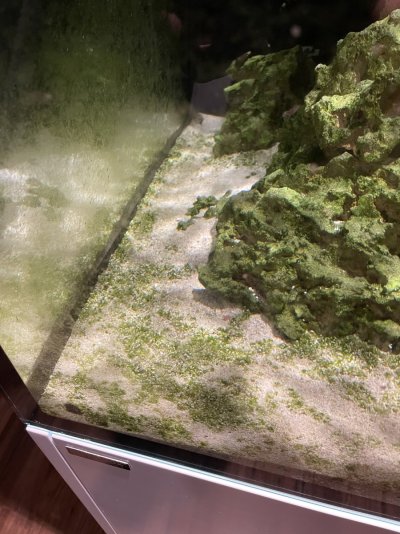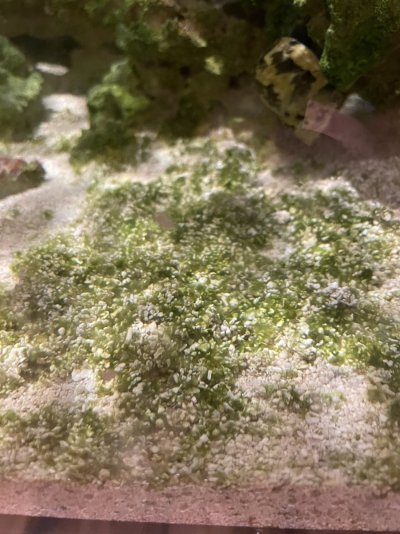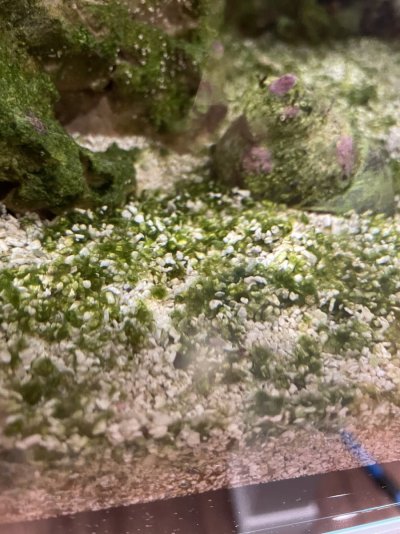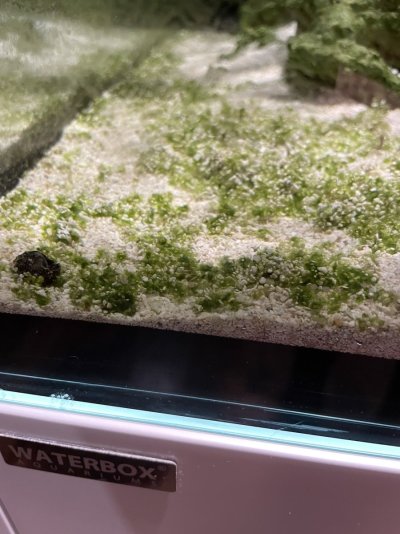Navigation
Install the app
How to install the app on iOS
Follow along with the video below to see how to install our site as a web app on your home screen.
Note: This feature may not be available in some browsers.
More options
You are using an out of date browser. It may not display this or other websites correctly.
You should upgrade or use an alternative browser.
You should upgrade or use an alternative browser.
Why???!!!!
- Thread starter Sylvester
- Start date
- Tagged users None
What’s your nutrient export method? The cycle usually will continue unless you can remove the nutrients from the system somehow. Die off just converts the algae into nitrates and phosphates which then feeds more algae growth.
If you kill algae with chemicals, all that happens is that they release nitrate and phophate back into the water, which then feeds the algae spores so the algae comes back.
Rather than using chemicals, you need to find and resolve the excess nutrient problem in your tank.
The algae on the sand could also be made worse by daylight hitting the tank, are there any windows nearby?
vetteguy53081
Well known Member and monster tank lover
View Badges
Partner Member 2024
Excellence Award
Reef Tank 365
RGB
Article Contributor
Tampa Bay Reef Keepers
West Palm Beach Reefer
Hospitality Award
Ocala Reef Club Member
305 Reef Club
Wisco Reefers
Midwest Reefer
Fish Medic
MAC of SW Florida
Rock Pool Reef Keepers
R2R Secret Santa 2023
My Tank Thread
My Aquarium Showcase
Can you get closer in on the algae pics?
Appears to be cyano. Just want to be sure. If it is, cyano blooms typically start when water nutrient concentrations go haywire and concentrations of phosphate, nitrate and other organic compounds are too high.
Some of the most common causes include:
- Protein skimmer which fills water with tiny air bubbles. As bubbles form from the reaction chamber, dissolved organic compound molecules stick to them. Foam forms at the surface of the water and is then transferred to a collection cup, where it rests as skimmate. When the protein skimmer does not output the best efficiency or you do not have the suitable protein skimmer to cover the tank, the air bubbles created by the skimmer might be insufficient. And this insufficiency of air bubbles can trigger the cyano to thrive.
- Overstocking / overfeeding, your aquarium with nutrients is often the culprit of a cyano bloom
- Adding live rock that isn’t completely cured which acts like a breeding ground for red slime algae
- If you don’t change your water with enough frequency, you’ll soon have a brightly colored red slime algae bloom. Regular water changes dilute nutrients that feed cyanobacteria and keeps your tank beautifully clear
- Using a water source with nitrates or phosphates is like rolling out the welcome mat for cyano. Tap water is an example
- Inadequate water flow, or movement, is a leading cause of cyano blooms. Slow moving water combined with excess dissolved nutrients is a recipe for pervasive red slime algae development
I recommend to reduce white light intensity or even turn them off for 5-7 days. Add liquid bacteria daily for a week during the day at 1.5ml per 10 gallons. Add Hydrogen peroxide at night at 1ml per 10 gallons. Add a pouch of chemipure Elite which will balance phos and nitrate and keep them in check.
After the week, add a few snails such as cerith, margarita, astrea and nassarius plus 6-8 blue leg hermits to take control.
Appears to be cyano. Just want to be sure. If it is, cyano blooms typically start when water nutrient concentrations go haywire and concentrations of phosphate, nitrate and other organic compounds are too high.
Some of the most common causes include:
- Protein skimmer which fills water with tiny air bubbles. As bubbles form from the reaction chamber, dissolved organic compound molecules stick to them. Foam forms at the surface of the water and is then transferred to a collection cup, where it rests as skimmate. When the protein skimmer does not output the best efficiency or you do not have the suitable protein skimmer to cover the tank, the air bubbles created by the skimmer might be insufficient. And this insufficiency of air bubbles can trigger the cyano to thrive.
- Overstocking / overfeeding, your aquarium with nutrients is often the culprit of a cyano bloom
- Adding live rock that isn’t completely cured which acts like a breeding ground for red slime algae
- If you don’t change your water with enough frequency, you’ll soon have a brightly colored red slime algae bloom. Regular water changes dilute nutrients that feed cyanobacteria and keeps your tank beautifully clear
- Using a water source with nitrates or phosphates is like rolling out the welcome mat for cyano. Tap water is an example
- Inadequate water flow, or movement, is a leading cause of cyano blooms. Slow moving water combined with excess dissolved nutrients is a recipe for pervasive red slime algae development
I recommend to reduce white light intensity or even turn them off for 5-7 days. Add liquid bacteria daily for a week during the day at 1.5ml per 10 gallons. Add Hydrogen peroxide at night at 1ml per 10 gallons. Add a pouch of chemipure Elite which will balance phos and nitrate and keep them in check.
After the week, add a few snails such as cerith, margarita, astrea and nassarius plus 6-8 blue leg hermits to take control.
My nitrates are .20 and phosphates 0.09Can you get closer in on the algae pics?
Appears to be cyano. Just want to be sure. If it is, cyano blooms typically start when water nutrient concentrations go haywire and concentrations of phosphate, nitrate and other organic compounds are too high.
Some of the most common causes include:
- Protein skimmer which fills water with tiny air bubbles. As bubbles form from the reaction chamber, dissolved organic compound molecules stick to them. Foam forms at the surface of the water and is then transferred to a collection cup, where it rests as skimmate. When the protein skimmer does not output the best efficiency or you do not have the suitable protein skimmer to cover the tank, the air bubbles created by the skimmer might be insufficient. And this insufficiency of air bubbles can trigger the cyano to thrive.
- Overstocking / overfeeding, your aquarium with nutrients is often the culprit of a cyano bloom
- Adding live rock that isn’t completely cured which acts like a breeding ground for red slime algae
- If you don’t change your water with enough frequency, you’ll soon have a brightly colored red slime algae bloom. Regular water changes dilute nutrients that feed cyanobacteria and keeps your tank beautifully clear
- Using a water source with nitrates or phosphates is like rolling out the welcome mat for cyano. Tap water is an example
- Inadequate water flow, or movement, is a leading cause of cyano blooms. Slow moving water combined with excess dissolved nutrients is a recipe for pervasive red slime algae development
I recommend to reduce white light intensity or even turn them off for 5-7 days. Add liquid bacteria daily for a week during the day at 1.5ml per 10 gallons. Add Hydrogen peroxide at night at 1ml per 10 gallons. Add a pouch of chemipure Elite which will balance phos and nitrate and keep them in check.
After the week, add a few snails such as cerith, margarita, astrea and nassarius plus 6-8 blue leg hermits to take control.
My skimmer pulls pretty good crap. I have carbon running 24/7 and a UV 24/7
I do weekly water changes. The tank is 130 gallons plus 35 gallon sump
It’s been running since October 2021
Attachments
So you saying nitrates and phosphates should be 0 ? I run carbon and UV -24/7What’s your nutrient export method? The cycle usually will continue unless you can remove the nutrients from the system somehow. Die off just converts the algae into nitrates and phosphates which then feeds more algae growth.
No GFO
vetteguy53081
Well known Member and monster tank lover
View Badges
Partner Member 2024
Excellence Award
Reef Tank 365
RGB
Article Contributor
Tampa Bay Reef Keepers
West Palm Beach Reefer
Hospitality Award
Ocala Reef Club Member
305 Reef Club
Wisco Reefers
Midwest Reefer
Fish Medic
MAC of SW Florida
Rock Pool Reef Keepers
R2R Secret Santa 2023
My Tank Thread
My Aquarium Showcase
Phosphate up a little which makes senseMy nitrates are .20 and phosphates 0.09
My skimmer pulls pretty good crap. I have carbon running 24/7 and a UV 24/7
I do weekly water changes. The tank is 130 gallons plus 35 gallon sump
It’s been running since October 2021
Have you tried manually removing it by siphoning the sand? Whether it’s cyano or an algae, the goal in the end is the same which is to not just kill it but get it out of the system. Killing it with chemicals but no other interventions will just convert the nutrients into another form and not actually get rid of them. If it is cyano there are some good articles out there on why it might be there and ways to get rid of it. Vetteguy mentioned some i from a good one (link below):My nitrates are .20 and phosphates 0.09
My skimmer pulls pretty good crap. I have carbon running 24/7 and a UV 24/7
I do weekly water changes. The tank is 130 gallons plus 35 gallon sump
It’s been running since October 2021

10 Easy Steps To Remove Cyanobacteria From Your Reef Tank (Now)
Cyanobacteria in a reef tank. Treatment and prevention. Exploring the world of red slime algae and how to get rid of it. Saltwater tank troubleshooting.
 www.reefhacks.com
www.reefhacks.com
I’m not an expert on ID of nuisance algae but if you are having recurring die off and regrowth, likely you are not actually getting it out of the tank or the eradication method was not complete or harsh enough. Just thought I would put my two cents in about killing algae and the thought that it will go away because most people don’t think of algae especially GHA as a reservoir for nutrients which just get converted back to dissolved nutrients in the form of nitrates and phosphates. When your nitrates and phosphates are low but you have you a GHA outbreak it’s because the algae just absorbed it but it is still in your tank just not in a measurable form. So you have to actually remove that algae from the tank to stop the cycle.
I spent a long time syphoning it all up. I had a white sand bed and now it’s coming back. I guess I gotta drop the phosphatesHave you tried manually removing it by siphoning the sand? Whether it’s cyano or an algae, the goal in the end is the same which is to not just kill it but get it out of the system. Killing it with chemicals but no other interventions will just convert the nutrients into another form and not actually get rid of them. If it is cyano there are some good articles out there on why it might be there and ways to get rid of it. Vetteguy mentioned some i from a good one (link below):

10 Easy Steps To Remove Cyanobacteria From Your Reef Tank (Now)
Cyanobacteria in a reef tank. Treatment and prevention. Exploring the world of red slime algae and how to get rid of it. Saltwater tank troubleshooting.www.reefhacks.com
I’m not an expert on ID of nuisance algae but if you are having recurring die off and regrowth, likely you are not actually getting it out of the tank or the eradication method was not complete or harsh enough. Just thought I would put my two cents in about killing algae and the thought that it will go away because most people don’t think of algae especially GHA as a reservoir for nutrients which just get converted back to dissolved nutrients in the form of nitrates and phosphates. When your nitrates and phosphates are low but you have you a GHA outbreak it’s because the algae just absorbed it but it is still in your tank just not in a measurable form. So you have to actually remove that algae from the tank to stop the cycle.
Get more things to eat it. Predation should be the main limiting factor for algae growth. Emerald and hermit crabs would be my go to, as well as the cerith snails that eat algae on the sand.
I spent a long time syphoning it all up. I had a white sand bed and now it’s coming back. I guess I gotta drop the phosphates
Yeah best approach will probably be a combination of some removal technique either manually or like spare time said with CUC and resolving the underlying nutrient issue. Which in this case might be phosphates. Not well versed on nutrient balance but it seems cyano is found in tanks with lower nitrate to phosphate ratios, so lowering the phosphates might help also.Get more things to eat it. Predation should be the main limiting factor for algae growth. Emerald and hermit crabs would be my go to, as well as the cerith snails that eat algae on the sand.
Lowering nutrients won’t help (it might if you go low enough, but then dinos will just grow which is much worse).
Try to get more herbivores.
Try to get more herbivores.
The reason your water column nutrients measure so low is because they are being consumed by algea leaving nothing to measure.My nitrates are .20 and phosphates 0.09
My skimmer pulls pretty good crap. I have carbon running 24/7 and a UV 24/7
I do weekly water changes. The tank is 130 gallons plus 35 gallon sump
It’s been running since October 2021
Trust me - you have a nitrate/phosphate issue or you would not have algae.
Thank you so much. I will balance those out to see what will happenThe reason your water column nutrients measure so low is because they are being consumed by algea leaving nothing to measure.
Trust me - you have a nitrate/phosphate issue or you would not have algae.
Similar threads
- Replies
- 4
- Views
- 544
- Replies
- 14
- Views
- 178
- Replies
- 9
- Views
- 250
- Question
- Replies
- 6
- Views
- 112


















